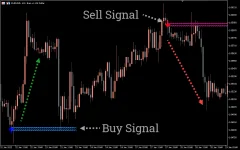- Joined
- Nov 3, 2024
- Messages
- 109
- Reaction score
- 1
- Points
- 16
Lucky Reversal Indicator
The Lucky Reversal Indicator is designed to identify trend reversals in the forex market. Its unique approach to trend reversal signaling makes it valuable, though it functions as a lagging indicator, meaning it signals only after a reversal is confirmed.

The Lucky Reversal Indicator is designed to identify trend reversals in the forex market. Its unique approach to trend reversal signaling makes it valuable, though it functions as a lagging indicator, meaning it signals only after a reversal is confirmed.

Key Features of the Lucky Reversal Indicator
- Reversal Signal Arrows:
- Displays blue arrows to mark an uptrend start and red arrows to indicate a downtrend.
- Wavy horizontal lines appear following each arrow, providing visual cues on price stability in the new trend direction.
- Lagging Nature:
- The Lucky indicator generates signals after the trend reversal has been confirmed, meaning it may not catch reversals immediately.
- This characteristic is ideal for confirmation rather than prediction, providing traders with assurance that a trend change is established before they enter trades.
- Strengths and Limitations:
- Its lagging quality is both a limitation and a strength—it may miss initial reversal opportunities but provides strong signals for ongoing trends.
- Useful as a trend confirmation tool, but traders should combine it with other indicators or market structure analysis (e.g., support and resistance) to enhance trade timing and accuracy.
Trading Strategies with the Lucky Reversal Indicator
- Using with Moving Averages:
- Combining the Lucky indicator with a moving average can create a trend-following strategy. For example, traders could enter trades once both indicators confirm the same trend direction.
- Take Profit and Stop Loss:
- Set take profit targets based on technical levels instead of waiting for an opposite signal.
- For stop losses, it is recommended not to risk more than 2% of the trading capital. The indicator’s wavy lines, which price rarely crosses, can serve as a guide for stop loss placement, but traders should assess if the risk/reward ratio remains favorable.





